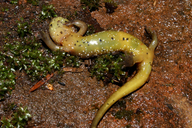|
Rhyacotriton cascadae Good & Wake, 1992
Cascade torrent salamander | family: Rhyacotritonidae genus: Rhyacotriton |
| Species Description: Good DA and Wake DB. 1992. Geographic variation and speciation in the torrent salamanders of the genus Rhyacotriton (Caudata: Rhyacotritonidae). University of California Publications in Zoology 126: 1–91 | |
 © 2016 William Flaxington (1 of 24) |
|
|
|
Description Distribution and Habitat Country distribution from AmphibiaWeb's database: United States U.S. state distribution from AmphibiaWeb's database: Oregon, Washington
Life History, Abundance, Activity, and Special Behaviors Information on diet of R. cascadae is not available, but adults and juveniles likely feed on a mixture of aquatic and semiaquatic invertebrates. Likewise, natural predators have not been documented but larval and adult Pacific giant salamanders (Dicamptodon), as well as garter snakes (Thamnophis) are probably important. See Petranka (1998) and references therein. Rhyacotriton respond to attacks by coiling the body and raising and undulating the tail which contains poison glands (Nussbaum et al. 1983). Larvae may be abundant and densities have been estimated at 28 - 41 individuals/m2 (Nussbaum and Tait 1977). Trends and Threats Comments
References
Bury, R. B. (1983). "Differences in amphibian populations in logged and old growth redwood forest." Northwest Science, 57, 167-178. Good, D. A., Wake, D. B., and Wurst, G. Z. (1987). ''Patterns of geographic variation in allozymes of the Olympic salamander Rhyacotriton olympicus (Caudata: Dicamptodontidae).'' Fieldiana, Zoology, 32, 1-15. Good, D. A., and Wake, D. B. (1992). ''Geographic variation and speciation in the torrent salamanders of the genus Rhyacotriton (Caudata: Rhyacotritonidae).'' University of California Publications in Zoology, 126, 1-91. Leonard, W.P., Brown, H.A., Jones, L.L.C., McAllister, K.R., and Storm, R.M. (1993). Amphibians of Washington and Oregon. Seattle Audubon, Seattle. Nussbaum, R. (1969). ''A nest site of the Olympic Salamander, Rhyacotriton olympicus (Gaige).'' Herpetologica, 25, 277-278. Nussbaum, R. A., Brodie, E. D., Jr., and Storm, R. M. (1983). Amphibians and Reptiles of the Pacific Northwest. University of Idaho Press, Moscow, Idaho. Nussbaum, R., and Tait, C. K. (1977). ''Aspects of the life history and ecology of the Olympic Salamander, Rhyacotriton olympicus.'' American Midland Naturalist, 98, 176-199. Petranka, J. W. (1998). Salamanders of the United States and Canada. Smithsonian Institution Press, Washington D.C. and London. Sever, D M. (1988). "Male Rhyacotriton olympicus (Dicamptodontidae: Urodela) has a unique cloacal vent gland." Herpetologica, 44, 274-280. Stebbins, R. C. (1985). A Field Guide to Western Reptiles and Amphibians. Houghton Mifflin, Boston. Welsh, H. H., Jr. and Lind, A. J. (1991). ''The structure of the herpetofaunal assemblage in the Douglas-fir/hardwood forests of northwestern California and southwestern Oregon.'' Wildlife and Vegetation of Unmanaged Douglas-fir Forests, USDA Forest Service, General Technical Report PNW-GTR-285. L. F. Ruggiero, K. B. Aubry, A. B. Carey, and M. H. Huff, eds., USDA Forest Service, 394-413. Originally submitted by: Meredith J. Mahoney (first posted 2000-07-19) Edited by: M. J. Mahoney (2001-06-04) Species Account Citation: AmphibiaWeb 2001 Rhyacotriton cascadae: Cascade torrent salamander <https://amphibiaweb.org/species/4232> University of California, Berkeley, CA, USA. Accessed Nov 23, 2024.
Feedback or comments about this page.
Citation: AmphibiaWeb. 2024. <https://amphibiaweb.org> University of California, Berkeley, CA, USA. Accessed 23 Nov 2024. AmphibiaWeb's policy on data use. |




 Raffaëlli Account
Raffaëlli Account Map of Life
Map of Life